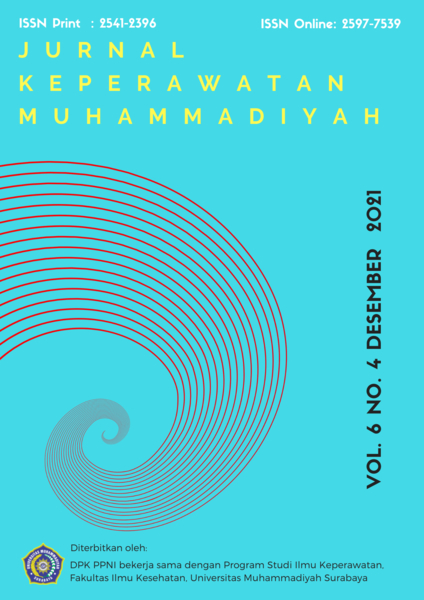Gambaran Status Gizi dan Aktivitas Fisik Remaja Selama Pandemi COVID-19
DOI:
https://doi.org/10.30651/jkm.v6i4.9621Kata Kunci:
Nutritional status, physical activity, teenagers.Abstrak
Objective: The covid-19 pandemic that occurred in Indonesia has brought many changes, especially for teenagers, namely the limitations in carrying out activities, online learning, and an appeal to stay at home to prevent the spread of the covid-19 virus. These changes can have various impacts on the nutritional status and physical activity of adolescents. The purpose of this study is to describe the nutritional status and physical activity of adolescents during the covid-19 pandemic.
Methods: This research method uses descriptive quantitative research method with a cross-sectional approach. This research was conducted at SMPN 2 Raren Batuah, Unsum Village, Raren Batuah District, East Barito Regency, Central Kalimantan Province in January - March 2021. This sampling technique used total sampling with a total of 91 male and female adolescent respondents with a range of ages 13 - 15 years (early teens). Data collection in this study used anthropometric measurements to measure nutritional status, and the PAQ-C (Physical Activity Questionnaire for Older Children) questionnaire to measure physical activity.
Results: The results showed that the nutritional status of adolescents based on BMI/U was in the normal category of 78% and the rest had nutritional problems. While the physical activity of adolescents based on the category that is light activity is 49%.
Conclusion: Based on the results of the study, there may be a relationship between nutritional status and physical activity during the covid-19 pandemic.
Referensi
Arief, N. A., Kuntjoro, B. F. T., & Suroto, S. (2020). Gambaran aktifitas fisik dan perilaku pasif mahasiswa Pendidikan Olahraga selama pandemi covid-19. Multilateral Jurnal Pendidikan Jasmani Dan Olahraga, 19(2), 175.
Arza, P. A., & Sari, L. N. (2021). Hubungan konsumsi sayur dan buah dengan status gizi pada remaja di SMP Kabupaten Pesisir Selatan. Jurnal Kesehatan Kusuma Husada, 12(2), 136-141.
Bucksch, J., Currie, D., Elgar, F., Hamrik, Z., Inchley, J., Keane, E., Kelly, C., & Rasmussen, M. (2017). Adolescent obesity and related behaviours: trends and inequalities in the WHO region 2002-2014, Observations from the Health Behaviour in School-aged Children (HBSC) WHO collaborative cross-national study. World Health Organization, Regional Office for Europe, 130(4), 207–217.
Efrizal, W. (2020). Persepsi dan pola konsumsi remaja selama pandemi covid-19. Jurnal Penelitian Biologi, Botani, Zoologi dan Mikrobiologi 5(2), 43-48.
Hendra, C., Manampiring, Aaltje E., & Budiarso, F. (2016). Faktor-faktor risiko terhadap obesitas pada remaja di Kota Bitung. Jurnal e-Biomedik (eBm), 4(1), 1-5.
Juniartha, I. G. N., & Darmayanti, N. P. E. (2020). Gambaran status gizi siswa sekolah menengah pertama (SMP) di Kuta, Bali. Coping: Community of Publishing in Nursing, 8(2), 133.
Kemenkes. (2011). Keputusan Menteri Kesehatan Republik Indonesia tentang standar antropometri penilaian status gizi anak. In Jornal de Pediatria (Vol. 95, Issue 4, p. 41).
Kemenkes. (2017). Hasil pemantauan status gizi (PSG) tahun 2016. Jakarta, Kementerian Kesehatan Republik Indonesia.
Kesuma, Z. M., & Rahayu, L. (2017). Identifikasi status gizi pada remaja di Kota Banda Aceh. Statistika: Journal of Theoretical Statistics and Its Applications, 17(2), 63–69.
Nugroho, A. M. A., Kinasih, A., & Messakh, S. T. (2018). Gambaran aktivitas fisik siswa dengan imt kategori gemuk di Sekolah Dasar Desa Butuh. Jurnal Mitra Pendidikan ( JMP Online ), 2(8), 730–737.
Nugroho, K., Natalia, G., & Masi, M. (2016). Perubahan indeks masa tubuh pada mahasiswa semester 2 program studi Ilmu Keperawatan Fakultas Kedokteran. E-Journal Keperawatan (e-Kp), 4(2), 1–5.
Pujiati, Arneliwati, & Rahmalia, S. (2015). Hubungan antara perilaku makan dengan status gizi pada remaja putri. 2(2), 1345–1352.
Riskesdas. (2013). Riset kesehatan dasar. Jakarta, Badan Penelitian Dan Pengembangan Kesehatan Kementerian Kesehatan RI.
Sari, A. M., Ernalia, Y., & Bebasari, E. (2017). Hubungan aktivitas fisik dengan kejadian obesitas aada siswa SMPN di Pekanbaru. Jom Fk, 4(1), 1–8.
Sibarani, I. H. (2020). Pengaruh pandemi covid-19 terhadap penurunan aktivitas fisik pada remaja selama lockdown. 2.
Silvano, H., SS, D., & TA, M. (2013). Hubungan tingkat konsumsi dan aktivitas fisik dengan imt (Index Massa Tubuh). Jurnal Kedokteran Muhammadiyah, 1(2), 49–53.
Suyasmi, N. M., Citrawathi, D. M., & Sutajaya, I. M. (2018). Hubungan pola makan aktivitas fisik pengetahuan gizi dengan indeks massa tubuh (IMT). Jurnal Pendidikan Biologi Undiksha, 5(3), 156–165.
Syahfitri, Y., Ernalia, Y., & Restuastuti, T. (2017). Gambaran status gizi siswa siswi Smp Negeri 13 Pekanbaru tahun 2016. Journal of Chemical Information and Modeling, 53(9), 1689–1699.
Utami, D. T., Hatijah, N., Shofiya, D., Gizi, J., & Kemenkes Surabaya, P. (2016). Efek aktivitas fisik terhadap status gizi remaja di Smp Muhammadiyah 5 Surabaya. Jurnal Gizikes, 2(1), 122–128.
Unduhan
Diterbitkan
Terbitan
Bagian
Lisensi
- Penulis tetap memegang hak atas karyanya dan memberikan hak publikasi pertama kepada jurnal ini yang secara simultan karya tersebut dilisensikan di bawah:Â Creative Commons Attribution-ShareAlike 4.0 International (CC BY-SA 4.0)









